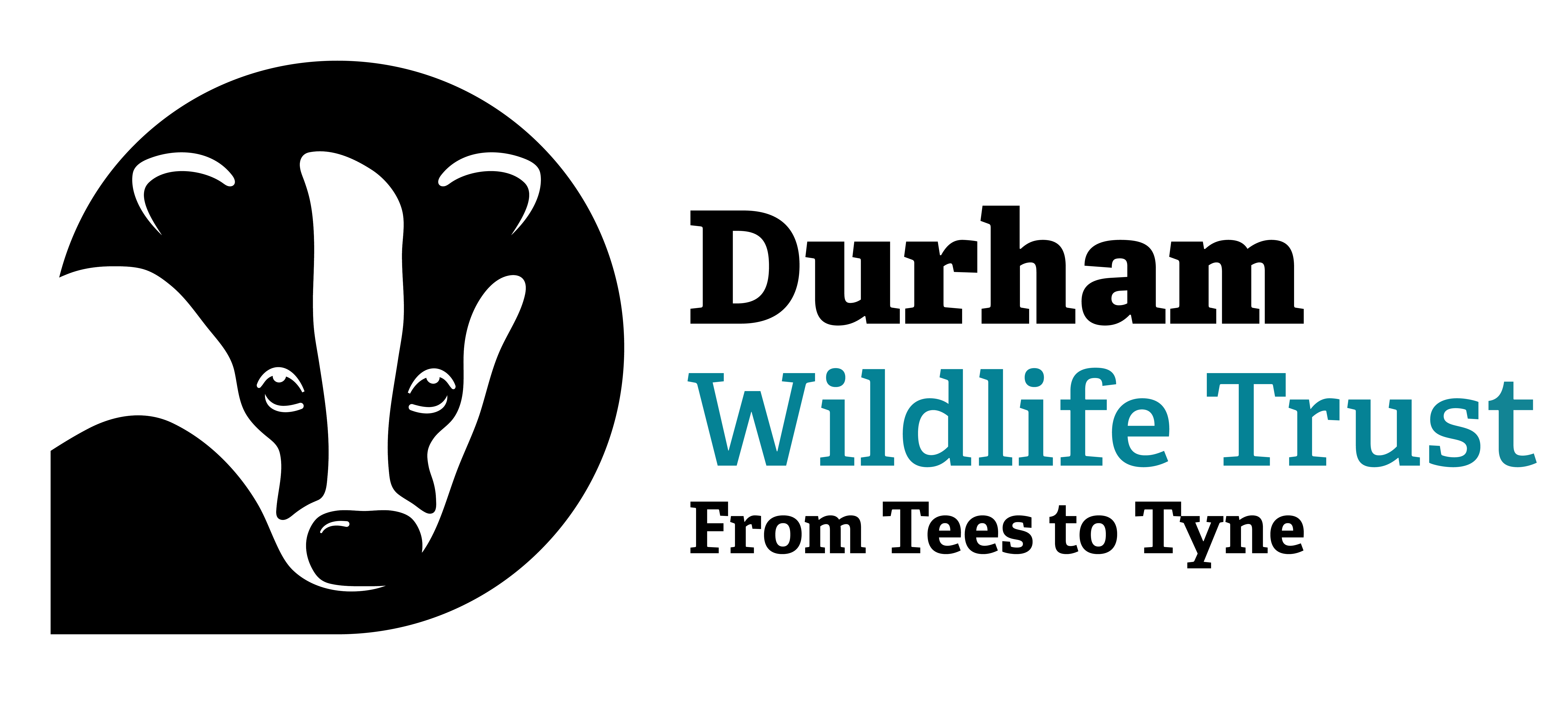Once again we have reached that bitter sweet time when we bid farewell to the little terns as they leave us at Seaton Carew and set off with their young to West Africa. Imagine, just a few weeks of age and our 125 fledglings (yes – ONE HUNDRED AND TWENTY FIVE) will take three months to complete a flight of 3000 miles to The Gambia. This has been a truly wonderful year for us, breaking all records for the Seaton Carew Project and also its predecessor in Crimdon Dene. So, this will be my final blog of 2023 and it will come as no surprise that I open with an appreciation and huge vote of thanks and recognition to the incredible volunteers, the Durham Wildlife Trust wardens and of course to the good people of SeaScapes, National Lottery Heritage Fund, Hartlepool Council and Durham Wildlife Trust who, through their commitment, coordination, support and generosity have made this all possible.
A farewell to the little terns and their fledglings
Little tern wardens: ‘Our doorstep’ at sunset (c) Derek Wood
By lead warden, Derek Wood
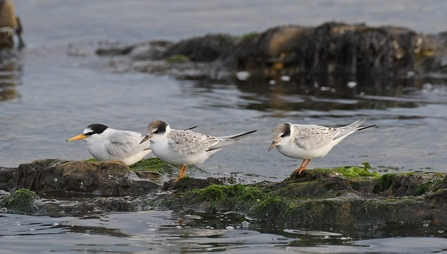
Little terns: one adult and two of our 125 fledglings making ready to leave in 2023 (c) Derek Wood
As the team have been so fundamental to this year’s success, I have invited them to draft a few words as a contribution to this final blog of the 2023……
SHONA
My experience of being a little tern warden
It was the middle of May and the little terns were well underway with their breeding behaviours when I began as a warden at Seaton Carew. Males were in courtship with females and other adults were already sat on scrapes awaiting the arrival of chicks. The site had been sectioned off into colour coded ‘zones’ so we could document where each scrape was and locate nests more easily. It wasn’t long before the first eggs were spotted and these eggs soon developed into chicks. As a warden I was surprised at how quickly the chicks grew up, from being small lumps of fluff the one week to doubling in size the next! From hatching to fledging, it seemed to happen overnight! I still can’t get over how cute the little balls of fluff were!
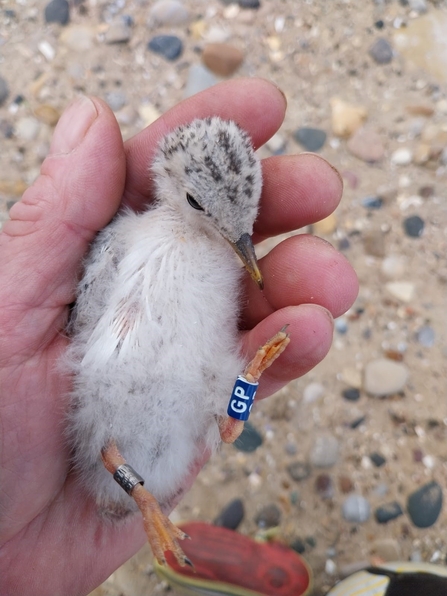
A ‘ball of fluff’ - little tern chick after ringing (c) Derek Wood
Part of the role of being a warden is to ensure the site gets disturbed as little as possible. On the whole people were very positive about the conservation effort we were undertaking and many showed a keen interest in the birds, which was lovely to see. We did have one or two people enter the site to retrieve balls but thankfully nothing that had a negative effect on the nesting birds. The only instances where nests were disturbed was due to wildlife, we saw weasel prints one morning (or as a member of the public pointed out “it could have been an escaped ferret!”), to seeing a chick predated by a sparrow hawk. But these small instances had little effect on the overall numbers that managed to fledge.
Well done to all the volunteers who gave up their time to protect these birds, to the night wardens chasing away the foxes who were hoping for an easy meal and to my fellow wardens, as without them all I am certain the number successfully fledging would have been much less. I will miss spending many happy afternoons on the beach observing the birds and sharing knowledge and conversation with others. It will be interesting to see how many return next year, I am hoping for even larger numbers as it will be the first set of adults to have fledged from Seaton Carew since the fence was installed.
KELSEY
As a volunteer warden this season I have been lucky enough to be part of the team overseeing the Seaton colony of little terns. As the season has progressed we have seen changes in the little terns as they display courtship behaviours, brooding their chicks and then later teaching the juveniles how to fly and practice flocking. The site has been a very dynamic place to spend the summer and each day something new pops up to keep you entertained.
I have always been interested in wildlife but being able to be involved in a local conservation effort has been an invaluable and rewarding experience and I look forward to the return of the little terns in future years knowing some of the chicks hatched this season will make the long trip back from The Gambia to hopefully return back to our beaches.
MIKE & SHEILA
Our Tern Summer
Compared to some of the hours spent on site by our other wardens and volunteers, Sheila and my contributions to the project can’t be described as particularly significant, doing our five hour shift on Saturday mornings. Prior to our “involvement” at Seaton, we’d watched the terns in previous years at, initially, Crimdon and, latterly, at Seaton. Our attendance certainly wasn’t ”taxing” and we have thoroughly enjoyed watching the site develop over the summer in terms of the birds pairing, nesting, eggs, chicks and young birds fledging. It was great to watch the mirror flying, the courtship gifts of sand eels and the feisty defence of the site by the birds against predators much bigger than themselves. It was great to get “up close and personal” with the terns to an extent not previously experienced.
But it wasn’t all about the terns as we also enjoyed the ringed plovers – they were bickering between themselves on our first visit, bickered all summer long and were still bickering in the rain last Saturday. They could start an argument in an empty room. A joy to watch kept us amused all summer.
The project, in terms of bird numbers, appears to have been a great success but we were very concerned to hear the reports from Longnanny regarding the decimation of the arctic tern chicks with avian flu. I was advised that the little terns had a mini defence system in that they naturally socially distanced themselves, not liking any encroachment on their personal space. Fortunately we seem to have avoided any little tern flu problems.
One of the “highs” of the project was our involvement with the general public and also with the locals on a regular basis like the lady who regularly returned from her early morning litter pick in the dunes and the gentleman on the mobility scooter with his lovely dog. Over the course of the summer, we had many conversations with the public and the vast majority were genuinely interested in the birds and what was happening. Some people had travelled considerable distances to come and see the birds and seemed impressed with our efforts.
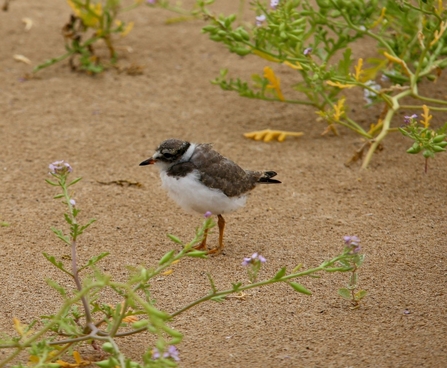
A ringed plover chick coming to the little tern party (c) Derek Wood
I don’t normally enjoy sea-watching but our perambulations around the fence perimeter gave us ample opportunity to watch inshore birds with the highlights being the sandwich terns and watching gannets diving to fish.
There were no real “lows”, even the weather was kind to us on Saturday mornings. One or two moans from dog walkers about taking up a large section of the beach. We pointed out the huge expanse of sand towards North Gare and I suggested that if they cared to keep walking they could probably get as far as Cornwall but, alas, they didn’t seem to have a sense of humour.
All in all, a wonderful summer and a great job done by the team. Derek gave me two pieces of information on our initial visit which proved invaluable:
- “Little terns are addictive, you’d better get used to it”
- “The Hidden Tap serves the best coffee in the North East”
Next season beckons?
SHIRLEY
I can say that I have really enjoyed volunteering with Seascapes to help look after the little terns. I was inspired by Mandy to do it. There are lots of interested members of the public who engage with us and we also help them in mastering the car park ticket machine. As far as I can say I will volunteer again next year.
AMY
Volunteering with the little terns project has been amazing. Getting to see their development from adults on the nests, to fluffy chicks running around to juveniles that are able to forage alongside the adults in such quick succession was a real treat. The site is really special with additions of ringed plovers nesting here too. One of my ‘highs’ of this season was getting to see the little terns band together to force the invading gulls from the protection zone and away from their chicks. It really shows how brave and powerful this species is when together. It was also really funny to see the ringed plovers chasing away the starlings and essentially telling them off. Additionally, getting to see the courtship behaviours and hearing the distinct chattering of the little terns is something I will treasure. I’ve even been lucky enough to see diving gannets and sandwich terns whilst on the site.
Throughout this season, I’ve been able to talk to visitors that had travelled from all over the country, constantly hearing how impressive the site was and a large part of that has to do with the huge commitment and passion from the wardens and volunteers, for protecting the little terns and ensuring they have a safe and good quality habitat to return to each year. Alongside the local community’s support for this protection zone. The sheer dedication to this project through the 24/7 monitoring of the site fills you with hope that there are lots of wonderful people willing to dedicate their time to protect wildlife for future generations. I would definitely recommend visiting the site next year, it’s not something you want to miss.
I’ve loved working alongside the other team members, they’re all really knowledgeable and welcoming and I feel that I’ve learnt a lot from them. I’m really going to miss spending afternoons on the beach, observing the birds and sharing updates and conversation with others. It’s definitely been an experience I won’t forget.
DOBRAWA
I really enjoyed working as a little tern warden this year. I spent my time at work with fantastic volunteers who are passionate about wildlife and it was great to work alongside them. It was great to see the interest from the public in our little terns nesting site too. And I especially remember talking for over 30 minutes with a young boy who showed genuine interest in the little terns and birdwatching in general. It’s a great feeling to know that we have added few sparks to ignite his passion for birds. Who knows, he may be a birdwatcher for life.
Observing little terns during their breeding season had helped me to find some valuable moments of reflection and gratitude for what I have. The nature on our doorstep is amazing and I think every once in a while, it’s fantastic to slow down and appreciate the beauty around us. Everyone can do a tiny bit to protect and preserve our natural environment for generations to come, even by things like giving the little terns some space while they nest and look after their chicks. Once again, thank you for this opportunity.
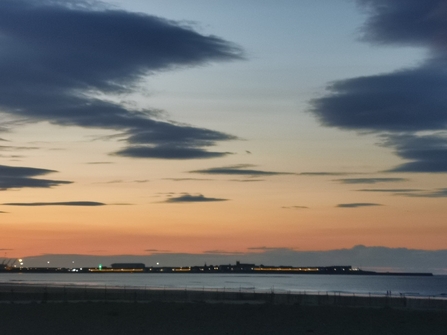
Little tern wardens: ‘Our doorstep’ at sunset (c) Derek Wood
TONY
This wonderful season has come to a close what seems all too quickly. But of course, that's what we want and welcome. Our success has undoubtedly been down to the input of all the agencies involved and the outstanding work of the warden team and my fellow volunteers. It has been a joy to work with you all and a pleasure to get to know you.
What has impressed me this year has been the tremendous support from the public, many of whom have taken the birds to their hearts. We have welcomed people from far afield and two occasions stay with me. One couple were sent down by Saltholme and nearly didn't bother, being a bit sceptical. They were serious spotters, their gear told me that, and spent their year touring sites around the country. They were speechless and said we had the best site they'd ever seen.
Another man had been to Orkney where the site had failed due to lack of care: we got it right, didn't we?
Well done the team, all at Durham Wildlife Trust and Hartlepool!
DEREK
And back to me………this has been my first year as Lead Warden for the Seaton Carew project and whilst it has been demanding on occasion, it has also been one of the happiest and most rewarding of times. The role obviously brings with it a greater responsibility for the team of wardens/volunteers, the site and of course for the little terns and the ringed plovers – but what an achievement by this fabulous team and by the unseen heroes back at Durham Wildlife Trust Rainton Meadows without whom we could have floundered (you know who you are!).
I write this final blog on the evening before the fence at Seaton Carew is dismantled and put into storage for another year. The beach will be made good and returned for the enjoyment of the public, a month or so sooner than in 2022, when the season was prolonged due to fox incursions which disrupted nesting. But we learned lessons from last year and introduced our night shift team as soon as the birds began to settle into their scrapes. Maintaining the night shift has shown itself to be crucial in protecting the birds and has been core to the amazing 2023 results and I’d like to pay tribute to my fellow nightshift workers who remained vigilant from 10pm to 5am every night, whatever the weather……foxes care not a jot about rain and wind.
But night shift does hold some surprises and rewards…………
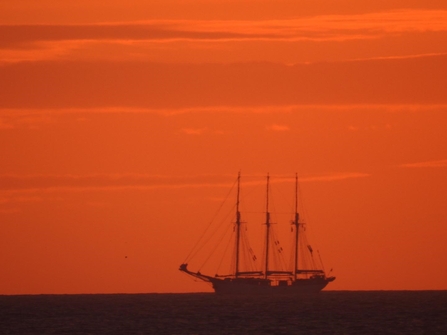
A tall ship off Seaton Carew at dawn (c) Dave Harrison
We never cease to learn and make new discoveries about the birds – and we also learn lessons about how we can improve to manage the project in future years. This year will be no exception and I’m confident that we’ll be back again next year to build and improve upon every aspect of our work.
To finish off, here’s a summary of the 2023 results………
125 little tern fledglings, 80 ringed, 25 ringed plover fledglings
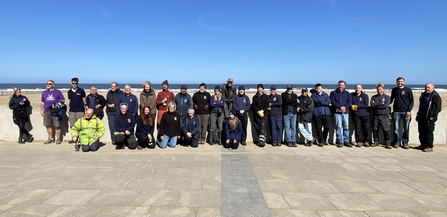
Little tern fencing volunteers

Support our work for wildlife
Help us protect species like the wonderful little terns. Please become a member of Durham Wildlife Trust today.
